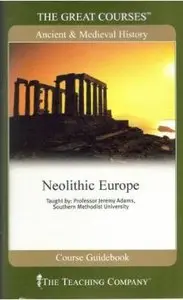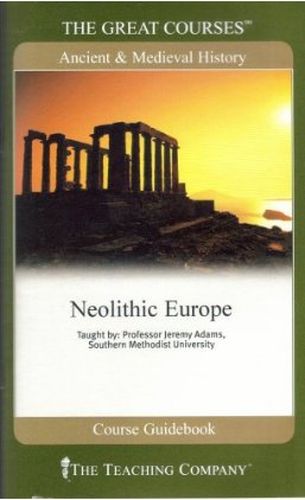Neolithic Europe (Audiobook) By Professor Jeremy Adams
Publisher: The Tea ching Company 2000 | 5 hours and 11 mins | ISBN: 1565853245 | MP3 | 81 MB
Publisher: The Tea ching Company 2000 | 5 hours and 11 mins | ISBN: 1565853245 | MP3 | 81 MB
Few may realize it amid today's swift changes, but the biggest technological shift in human history isn't the Internet. Instead, it was a process that took place more than 8,000 years ago and involved nothing more sophisticated than some seeds and a few crude hand tools. That shift was the Agricultural Revolution of the Neolithic Era or New Stone Age, which is what scholars call the time that began with the end of the last massive retreat of the ice caps, about 10,000 years ago. No written records exist to chronicle this great change in human life, but after taking Professor Jeremy Adams's course on Neolithic Europe, you'll have little doubt that this deep, prehistoric past remains very much alive and with us today in a myriad of ways that affect everything from our diet to the way we think of religion, politics, the family, and human finitude itself; in fact, this era established patterns of livelihood and social and religious order not decisively changed until the Industrial Revolution beginning in the 18th century. Professor Adams maintains that these are fundamental structures of human life whose origins run so deep that they are scarcely affected by the surface currents of mere "historical events." "This is a course in the Neolithic prehistory of the West, especially Western Europe, especially Britain," states Professor Adams. "It stretches across nearly 10 millennia of time, from 10000 or 8000 B.C.E. in Western Asia to 1350 B.C.E. in southern Britain, by which time Stonehenge was complete." To set the stage for this discussion, Professor Adams begins by defining key terms and describing the environmental conditions—often called the Neothermal Climate Change—which supported the invention and maintenance of agriculture and pastoralism around the 8th millennium B.C.E. and produced the basic climate we know today. Then, we consider the term "Agricultural Revolution" and the alternative (in fact, older) term "Neolithic Revolution." From the uplands of southwest Asia, agriculture spread slowly up the Danube and along the Mediterranean coast all the way to the Atlantic. Here your learning takes a turn toward the captivatingly detailed as you follow Professor Adams's close examinations of three sites that define the range of early−Neolithic cultural possibilities: Jarmo in present−day Iraq, the famous walled city of Jericho in Palestine, and Зatal Hьyьk in Turkey. These case studies frame the topic of the Agricultural Revolution's movement westward. Among the cultures that grew up along its path, you will focus on the strikingly skillful use of stone that can still be seen in the egg−shaped houses and raised central avenue of Khirokitia; the wooden longhouses of cattle−raising Danubian farmers; and the conclusions that may be drawn from a shrine to the dead in the Cueva de los Murciйlagos (Cave of the Bats) in southeastern Spain. In order to get a clear and multidimensional sense of the life of our Neolithic forebears, it is necessary to look at one or two case studies in greater detail. Whoever our genetic ancestors may be, any member of a modern English−speaking society benefits from the cultural legacy of the British Isles. This course concentrates on the first highly developed Neolithic culture of southern Britain, the Windmill Hill Culture, established in the late 5th millennium B.C.E., which constructed one of the world's most massive and mysterious megalithic monument complexes at a place now known as Avebury in the County of Wiltshire. The stages of the Windmill Hill Culture's development produced at first distinctive long barrows, then ritual centers of community life now misleadingly called "causewayed camps," and finally "henges," the functions of which are still hotly disputed by professional archaeologists and imaginative speculators alike. Avebury was—and in terribly ruined condition still is—an extraordinary place. Who built it, and why? How long did it take? To set it in context, Professor Adams surveys rapidly the range of megalithic cultures (a specialized type of Neolithic culture) in Western Europe, from southeastern Spain to Scandinavia, concluding with the navigationally sophisticated megalithic complex at Carnac in Brittany. While in their megalithic phase, the Neolithic farming and stock−raising communities of Britain interacted with newcomers from the European continent, now called the Beaker People, who brought with them bronze metallurgy, horses to ride and draw vehicles, the art of brewing beer, and a strikingly individualistic lifestyle.
Be Happy!!!
!!!No Mirrors below, please! Follow Rules!



